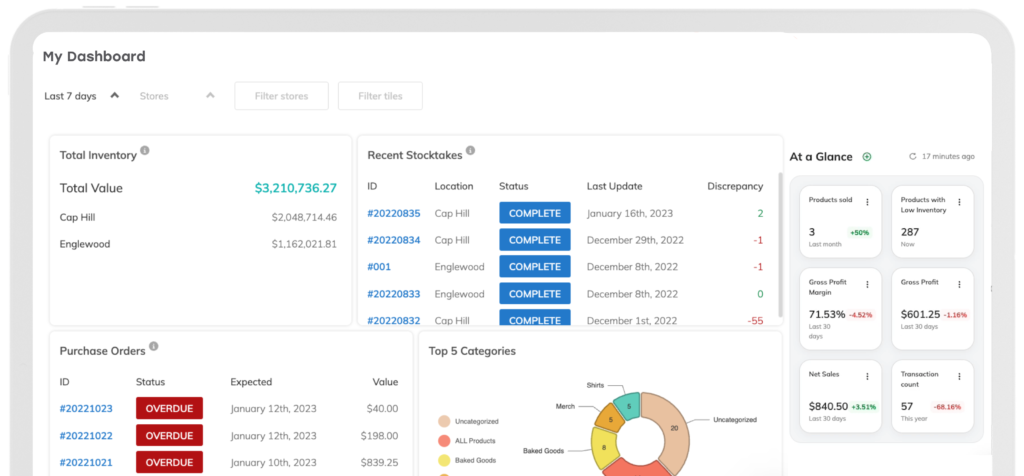
The Complete Guide To Inventory Management
The lifeblood of all small businesses that sell products is their inventory. With a strategic approach to inventory management, you can streamline stock tracking and management. These processes are essential for smooth daily operations, as they ensure customers get the products they want while you hit the “sweet spot” of carrying just the right quantities in stock.
This guide gives you a complete overview of the key elements of small business inventory management. You’ll also learn some helpful techniques and best practices for inventory management you can put to work in your business.
What You'll Learn In This Blog
- What is inventory management?
- The different types of inventory
- 5 benefits of inventory management
- 5 challenges of inventory management
- Types of inventory management
- How inventory management is conducted
- 6 inventory techniques to know
- How to track inventory levels
- 4 inventory questions to ask yourself
- The importance of using an inventory management system
- Best practices
What Is Inventory Management?
Inventory management is the process of ordering, producing, tracking, and selling products for a business. Although this term is sometimes used interchangeably with stock management, it’s important to understand the difference.
Inventory management vs. stock management
The inventory management process involves managing products that are for sale, items that are in production, and the materials that go into making those products. Stock management, on the other hand, refers to the process of handling solely finished products that are on display or in your storage room.
Inventory management vs inventory control
Another important distinction to note is the difference between inventory management and inventory control. Inventory control is an aspect of inventory management that optimizes the products you already have on hand. Take the example of a women’s clothing boutique. Inventory management processes would reorder a best-selling scarf in time for Mother’s Day. Inventory control would take note that a different scarf design is not performing as well and may need to go on sale.
The Newsletter For Small Businesses
Weekly expert insights, industry trends, and inspiring stories designed to help you run your business with confidence.
What Types Of Inventory Are There?
Raw goods
Raw goods are the basic materials used to manufacture products. Fabric and metals are some of the most commonly used raw materials, though there are many kinds. For example, if you sell candy that you make yourself, some of your raw materials might be sugar, corn syrup, and flavoring.

Work-in-progress
Work-in-progress inventory includes products that are partially completed. These items can be at any stage of the production phase, whether that’s preparation or packaging. In the example of the candy store, lollipop molds in the finishing stages when they’re sitting and cooling would be considered a work-in-progress before they’re wrapped.
Finished goods
Once your work-in-progress inventory is ready for sale, these products become finished goods. At this point, the lollipops from the candy store example would be packaged and listed among what’s available for customers to buy. You might sell them to customers, wholesalers, or other retailers. Either way, these products have fully completed their production phases and are ready for sale.
In-maintenance and repair
In-maintenance and repair goods are items used to make products but aren’t a part of the finished products. Equipment, cleaning supplies, and office tools are some examples of items classified as such. When you make your lollipops, the mixing bowls, molds, and thermometer will fall under this type of inventory.
5 Benefits Of Inventory Management
1. Better inventory storage
Inventory storage is more than having a warehouse or in-store product displays. It is a whole system that ensures the products you have in stock efficiently get to your shoppers in a way that can be tracked. With effective stock management, you can properly cycle through your products so nothing sits around on your shelves for too long, reduce theft, and have accurate stock counts.
If you keep items in storage, stock management is especially important – you might be paying for the amount of storage space you’re using. With optimized management, you can keep items steadily flowing into your business – and into customers’ hands – so that you use less space and save on storage costs.
Power Up
Learn tips and tricks for storing your inventory and making the most of your space.
2. Lower chances of overselling
Overselling, or the practice of selling more than what’s actually available can quickly sour a business’s reputation in the eyes of an affected customer. Proper small business inventory management precisely tracks what’s in stock, minimizing the possibility that a certain item is oversold. With proper stock management, You can rest assured knowing that, if you’re managing your inventory right, the stock counts you’ve listed are accurate. You’ll never worry whether you have enough products in stock to fulfill customer orders, and that will keep your customers happy.
Automate Re-Ordering With Thrive Inventory
Never turn another shopper away due to a stockout with Thrive Inventory’s suite of fulfillment tools. Thrive Inventory tracks stock levels, provides smart forecasting data, and automates purchase orders for you.
3. Identify sales trends
You can easily keep track of which items are flying off your shelves and which ones have been slow to move with the right management system in place. You can then make purchasing decisions accordingly.
You can also incorporate this information into your marketing strategy. Whether you’re marketing a best seller or you’re moving excess inventory, this information can help you determine which sales, promotions, or discounts to run.
4. Calculate inventory valuation
Your inventory is your business’s biggest asset. Knowing the value of the stock on your shelves and in your storage room lets, you know how much potential revenue you’re working with. That value is your inventory valuation.
Ending inventory is your inventory valuation at the end of the year, a key part of the financing, taxes, and forecasting purposes. But coupled with the holiday rush and everything else you need to get ready for the new year, retailers can feel the pressure. Proper, thorough inventory management simplifies this process, as you’ll have months of solid record-keeping under your belt.
Power Up
Learn everything you need to know about ending inventory by reading How To Calculate Ending Inventory Like a Pro.
5. Improve organization
Without an effective strategy, it can be easy to get lost in all the tracking and storing required to properly manage stock. Using proper inventory management techniques instead can help you stay organized during all the stages of your products’ life cycles. You’ll have a clear view of your product expiration dates, accurate stock forecasts, and many other factors that influence your business’s operations and success.
5 Challenges In Inventory Management
1. Inaccurate tracking
This happens when your records don’t match the physical stock you have in your back office or on the shelves. Inaccurate inventory records often lead to headaches when it comes to bookkeeping, stockouts, and making poor business decisions.
For instance, your business might experience inventory shrinkage. This means that your system is showing that you have more or fewer items than what’s actually available. As such, inventory shrinkage puts you at risk of overselling products and needing to refund customers.
Your log might indicate that you have fewer items than you actually have on-hand, whether due to inaccurate sales tracking or shrinkage. As a result, you might order or produce more than you need, which can increase your production and storage costs.
2. Unexpected changes in demand
As much as you might try to forecast customer demand, there may be periods when your stock moves much slower or faster than you expected. Knowing how to manage inventory for your small business can be tougher when you don’t know who’s buying what when – and in what quantities. For example, the “fidget spinner” trend took retailers by storm in 2017, and quickly dropped a few months later. Such a sudden drop in popularity resulted in retailers being stuck with extra inventory and with no way to sell it.
3. Inexperienced management staff
As a business owner, you might feel the urge to be in charge of every aspect of your business so everything goes according to plan. However, since you likely can’t do everything yourself, you’ll need staff to oversee the inventory management process.
But hiring or training experienced team members doesn’t happen overnight. You’ll need to ensure your employees understand the ins and outs of managing inventory. They should also be masters of your business’s ordering process, production phases, and stocking methods.

4. Lost inventory
Preventing stock from being lost or wasted is one of the key priorities of inventory management for a small business. However, there may be times when a box arrives damaged and the materials inside are unsalvageable. Or maybe you forgot to return to some work-in-progress items only to later realize they’re spoiled and need to be thrown away. In cases like these, you’ll need to adjust your process while finding ways to help prevent these issues from happening again.
5. Software choices
A dedicated software platform is key to accurately and effectively keeping track of your items. However, there are hundreds of options when choosing the right software for small businesses.
Though it can be time-consuming, you’ll need to sort through all the options to find the one that works best with your business’s other platforms. In particular, your inventory management software should sync with your POS system and scale with your company as it grows.
Try Inventory Management Software For Free
Thrive Inventory is your central hub for inventory management and reporting, reducing the painful manual process so you’re free to grow and manage your business.
Types Of Inventory Management
Storefront retail inventory management
If you have a retail business, you’ll need to make sure you have enough product in storage or in your store to meet customer demand. This process also involves keeping the right amount of items for sale on hand at all times. This way, you aren’t always running low on stock or wasting products or storage space with excess inventory.
If you use a point of sale system, like Square, Clover, or Shopify POS, your stock counts will automatically be adjusted each time you check out a customer.
E-commerce inventory management
E-commerce inventory management is quite similar to its retail counterpart. The main difference is that, with an online store, your stock counts will need to be updated after each e-commerce transaction. This way, you can accurately show which products are in stock, running low, or out of stock.
E-commerce platforms, like Shopify, Square Online, and BigCommerce automatically track and update available stock, and since there’s no other sales channel to reconcile, you can use those numbers as they come in without any other adjustments.
Multiple sales channel inventory management
Maybe your business has multiple locations and an online store. With multiple sales channel inventory management, you’ll need to know how to keep track of your items across all your sales channels.
Balancing inventory across multiple channels can be complex. This process has to be done quite carefully, or it can easily lead to out-of-sync stock counts that affect all your sales channels.
Power Up
Here’s how to increase customers’ buying opportunities and build customer loyalty with multichannel selling.
Manufacturing inventory management
Manufacturers, crafters, and even bakers have an added level of inventory management. Not only do they have to track the finished goods but the individual components that go into it. For instance, if you make bracelets that means knowing how many beads, strings, and clasps to purchase to meet consumer demand.
Wholesale inventory management
Wholesale inventory management involves creating and implementing systems so you can fill the largest of your orders without keeping too much on hand. When you’re running a wholesale business, you can easily send off hundreds or thousands of products in just one order. Keeping accurate counts is essential to maintaining your profits and getting customers and retailers the exact orders they placed.
Power Up
Learn how to diversify your business by selling in bulk to other retailers by reading Selling Wholesale To Retailers 101.
How Inventory Management Is Conducted, Step By Step
8 Inventory Management Best Practices
Ordering inventory
This involves submitting orders to bring products or raw materials into your business. When ordering inventory, you’ll need to determine who you want to work with, the best time to order products, and exactly which products you need to purchase. This way, you’re limiting your costs and minimizing waste while partnering with reliable and reputable vendors.
Receiving inventory
How To Track Inventory Levels
The next stage of inventory management is receiving and processing what’s coming in. This phase involves unboxing, inspecting, and sorting all the items in your order. You’ll need to review the number of products you received, their quality, and when the order arrived and compare it to your purchase order. This way, you can determine if your supplier properly fulfilled your order or if there are any issues you need to correct.
Storing inventory
Whether you’re running a storefront or an e-commerce store, you’ll need a dedicated place and process for storing your inventory. Effective management also means maintaining a strategic system for keeping all your products organized. Labeling and arranging items are key to this process.
Fulfilling inventory for a purchase
When a customer makes a purchase, the sale is more than a transaction between you and the customer. In inventory management, fulfilling an order initiates actions behind the scenes that record the sale and subtract that item from your stock.
This process involves packing items and sending them off to customers. You can do this in your store, through delivery, or in a package in the mail.
Cycle counting is when you periodically count individual groups of inventory. With cycle counts, you rotate through stock to make sure your inventory counts are up to date and correct. They’re basically a shortened version of a year-end stock count.
Cycle counting is a great technique to use alongside ABC analysis. You can determine which product groups you should count the most frequently based on their priority. For example, you might decide to count items in Category A once a month and items in Categories B and C once every other month.
6 Inventory Techniques To Know
Just-in-time inventory
This technique, called JIT for short, is one in which you schedule raw materials to arrive at your business just as you’re about to start production. If, for example, your business specializes in making gift baskets, you wouldn’t have an inventory stocked with varieties of candies, lotions, teas, and beverages. Instead, you’d receive the items you need for orders as customers place them.
Since you’re only buying what you know you’ll need, the JIT approach helps you limit waste. It also helps increase your cash flow since you don’t have money just sitting on the shelves, waiting to be sold.
Made-to-stock inventory
The opposite of JIT, made-to-stock is when you tie what you order to production demand. This approach utilizes demand forecasts to predict expected sales for an upcoming period and orders items to satisfy that expected demand. This method ensures that supply is on hand when needed, but over-ordering or under-ordering is possible.

ABC inventory analysis
The activity-based costing (ABC) analysis technique involves classifying your inventory according to how these items contribute to your business. This method determines value through the amount of revenue your items generate. There are three categories in this technique.
Category A includes the top 20 percent of inventory that generates 80 percent of your business’s profits. Category B includes the middle 30 percent which produces 15 percent of your profits. Category C includes the remaining 50 percent that only generates five percent of your business’s profits.
Let’s say you own a running store and you carry 15 styles of shoes that are your most popular and expensive products, they would be in Catagory A. If you have a large selection of clothes that sell consistently well, they might be in Catagory B. Then Category C would include the rest of your products, such as energy gels, shoe inserts, and gloves.
Cycle counting
Tools That Will Make Your Next Stock Count Easier
We built the tools you need for your next stock count, from a comprehensive guide to a printable worksheet for your count.
FIFO and LIFO
In the first-in, first-out (FIFO) method, the items you purchase first are what you sell first. This approach helps ensure you’re using what you bring in instead of it taking up space on your shelves and potentially expiring.
The last-in, first-out method (LIFO), on the other hand, sends out the inventory you most recently purchased first. This method is ideal for products that don’t expire. Business owners typically use this method when inventory costs have increased significantly.
With this method, you can report these more expensive purchases to note lower profits which, in turn, can reduce your tax burden. It’s an inventory management strategy that can be financially beneficial beyond your storage space.
Safety stock
Safety stock is extra inventory you keep in storage in case your business suddenly runs low. Safety stock can come in handy during instances such as unexpectedly high demand or delays in supplier shipments. These extra products can act as a buffer for your business’s inventory as you work on resupplying items.
Min/max levels
Setting minimum and maximum levels, also known as PAR levels, is one of the simplest ways to optimize what’s on hand. The minimum level is the smallest amount of a certain product you can have on hand before you need to place another order. The maximum level is the largest quantity you should have in stock. By tracking minimum and maximum levels, you can compare the inventory you have to these levels to determine how you need to proceed.
Thrive Inventory PAR Levels
With Thrive Inventory you know when a product reaches its minimum stock level and can generate a purchase order or internal transfer with low-stock products at the click of a button.
Stock forecasting
With stock forecasting, past data and trends inform how much inventory you keep on hand and when you should reorder items. You can look at market trends and sales data from similar periods to estimate how much to stock. Based on your analysis, you can gauge customer demand and determine how much inventory you need to reorder and when.
Inventory turnover
Inventory turnover measures the rate at which items are sold or restocked within a certain period. This value equals the cost of goods sold divided by the average value of your inventory.
A high turnover ratio could show that you’re having strong sales. However, it could also mean that you aren’t supplying your business with enough product to meet demand. Low turnover, on the other hand, could either mean your sales are low or that you don’t have the right product assortment for your shoppers.
Days inventory outstanding
Abbreviated as DIO, this is the average number of days your business holds inventory before selling it. This figure can help you see which items are moving quickly and which products are slower to sell.
To calculate your business’s DIO, you take the average inventory value and divide it by the cost of goods sold. You then multiply that value by the number of days in your inventory period. The lower the resulting number, the shorter the period in which your business stores items before turning them into sales. A higher number shows that your business takes more time to sell inventory.
Economic order quantity
Economic order quantity (EOQ) is a technique that helps you find the ideal amount of inventory your business should store. The goal is to meet customer demand without overspending on storage costs.
There are different formulas you can use to calculate EOQ, and several factors can affect this value. These factors include the time between placing and receiving an order (lead time), the cost per unit, and your stock reorder points. One common formula is EOQ = square root of [2(setup costs)(demand rate)] / holding costs.
Tools That Will Make Inventory Management Easier
We built the tools you need to manage your inventory, with 7 comprehensive guides and printable worksheets.
4 Inventory Management Questions To Ask Yourself
Which products should I stock?
One of the first steps to managing inventory is determining which items you need to have in stock. What products does your business sell? Do you need any raw materials to manufacture your products? What kind of product assortment is enticing to customers? Asking yourself these questions can help you determine which products are a priority for your business.
Power Up
Make product decisions based on data, not intuition, using our blog Optimizing Your Product Assortment.
How should I stock my items?
Determining how you’ll stock your inventory involves identifying approaches to processing and storing your products. Knowing how you’ll tackle these steps can help you optimize your storage options while making the best use of your and your employees’ time. Options include storage in a back office, utilizing a warehouse, renting a storage unit, and merchandising stock on the shop floor.

What reporting can I use?
There are several types of inventory reporting that track dead inventory, expiration dates, and many other aspects of the items you sell in your shop. These reports can help determine when to reorder products and see which products you should stock up on to meet customer demand.
Where are my employees getting stuck?
Even with the best strategies in place, there will always be ways you can improve your inventory management. You might find that you need to conduct more frequent cycle counts, adjust your reordering schedule, or purchase additional storage space. Asking yourself this question every now and then can help you keep improving your inventory management processes – and your business as a whole.
The Importance Of Using An Inventory Management System
The right system can help you determine exactly how to organize your small business inventory and your processes. This way, staying on top of product labeling, ordering schedules, stocking, and forecasting becomes much easier.
For small businesses, good inventory management and careful tracking are vitally important. Oftentimes, it can mean the difference between big profits and big blunders. At any moment, you can see what products you have in stock and which items you need to prepare to reorder.
As you’re on the hunt for software that suits your business, there are some key features you’ll want to consider. For example, information updated in real-time is key to an accurate view of your inventory. That’s why you should look for a program that provides real-time tracking and values.
Good inventory management software, through which you can input reorder points and get notifications when stock is low, can help you avoid running out of products. A program that generates purchase orders and helps you manage vendor and supplier information can make recording time a breeze.
What to look for in an inventory management system
- Integration with your e-commerce and point of sale (POS) system: The best inventory management systems work wherever you sell, whether that’s e-commerce, brick-and-mortar, traveling inventory, or some combination of these outlets. Be sure your system properly tracks stock levels in each location.
- Tools to sync stock counts across sales channels: These tools ensure that you can monitor all stock from one platform.
- Features that help grow your business: The right system supports your business as you scale. Look for integrations like Google Shopping support and features like wholesale support that help you reach new customers.
- User permissions: Access levels allow you to choose who on your team can make changes on the back end. The right system also tracks who’s doing what, so you can pull up a change log if anything looks awry.
- Automation: Time is money, and the right system offers tools that shave significant time off the important tasks required for proper inventory management. Three common examples are barcode scanning, min/max level monitoring, and alert systems.
Try Inventory Management Free For 30-Days
Thrive Inventory takes your POS and e-commerce system further with advanced features such as custom reporting, bundling, automatic purchase orders, cycle counts, and more.
1. Invest in barcoding
Yes, this does mean buying physical hardware. Fret not, though – a $20 barcode scanner and a $40 label printer can save you countless hours of manual typing and correcting mistakes.
Most scanners act like a keyboard, so instead of typing, you can scan wherever you need the number. No double-checking what you typed, no reading glasses – just point and scan.
2. Ensure your items are easily cataloged and referenced
Once your inventory is in your system, you should be able to look it up with ease. Invest some time upfront into setting up a clean, detailed database. It can save you an eternity in the long run.
Creating naming and numbering standards – and sticking to those standards – is key to this system working. This can involve codes for product type, following a system for model numbers, and adding indicators for SKU variety. For example, if you sell jewelry, you could use “R” to represent rings and a numerical value that represents a particular design. Use the fields available in your inventory management system, and add indicators for reference. For example, use “-SL” on SKU numbers for silver rings and “-GL” on gold.

3. Delegate tasks
Good inventory management involves sharing the workload. Don’t carry the tasks entirely on your shoulders – instead, involve your team in your processes.
To start delegating, identify which tasks can be given to others, create a system, and then monitor how it’s going. Some of the tasks you can delegate include generating reports, arranging purchase orders, and coordinating processes at the warehouse.
While you want your team to contribute to the inventory management process, safeguards and access controls are key to any inventory management software solution. You may want your employees to receive a new box of products, but that doesn’t mean they should have access to view your total profits. And if something changes incorrectly or inventory goes missing, you need to be able to find out who was responsible.
4. Always set two checkpoints
To reduce the chances of human error affecting your inventory, set up two checkpoints in your inventory management process. First, perform a count as soon as the shipments arrive at your business. Record the date you received them, along with the amount and quality. A second checkpoint can be when you’re putting away your items. These counts can occur as you’re displaying your products or putting them into storage.
5. Sync inventory levels between channels
If your business has multiple sales channels, it’s important to sync your inventory across those platforms. For example, instead of allocating 15 journals to your website and 16 journals to stock in your store, mark your inventory as 31 journals. If you sell a journal on your website, the total number of journals will go down to 30.
6. Review supplier performance
A supplier whose shipments are often late or below the quality you expected can cause major problems for your inventory process. You should periodically review your suppliers and how happy you are with their shipments, timeliness, and communication. From there, you can note any issues you need to address before your next order cycle.
Power Up
Learn vendor management best practices and how to find suppliers for your business with Vendor Management 101.
7. Audit regularly
Good inventory management requires regular auditing. This process takes out the guesswork of where and when items were sold. It’s how you can trace back every sale and adjustment.
Without an audit, you might spend hours one day trying to find a case of garden hose nozzles you had in storage. However, by completing these processes every now and then, you can check your records and see you moved the sprayers to your business’s second location.
8. Train your staff on proper procedures
Your employees likely have a variety of professional experiences, especially when it comes to inventory management. Even if you have a team of experts, you’ll want to offer training so everyone is up to speed on your processes and techniques. You can create a training program and integrate it into your staff training when you’re welcoming new team members into your small business.
Starting With The Basics
At first glance, inventory management might seem like a mix of several daunting processes. But with the right strategies in your back pocket and an eager team, your inventory management can be seamless. As you start implementing intentional practices into your business’s everyday operations, you’ll likely see your business’s productivity and efficiency reach new highs. And more efficient processes mean more time back to spend improving and growing your business in all kinds of other ways.
The Only Inventory System That Actually Helps You Run A Healthy Business
Thousands of customers all over the world use Thrive Inventory to run a healthy business.
Thrive Inventory gives you control over all your inventory, sales channels, and metrics, allowing you to make the right decisions at the right time.
Keep Reading

The Newsletter For Small Businesses
Weekly expert insights, industry trends, and inspiring stories designed to help you run your business with confidence.
Try Thrive Inventory For Free
Add Thrive Inventory to your business and maximize your potential. With powerful and easy-to-use products, it’s time to take control of
your business and see what you can do with Thrive.




